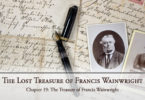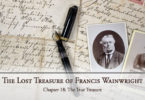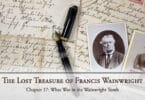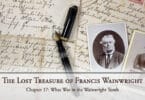Getting the key to the Wainwright tomb out of the hands of the town hall and back into the hands of the family was easy. All the Willick grandchildren had to do was ask, as they had already proven their direct descent from Francis, the original owner of the tomb. Since no other branches of the Wainwright family had made a claim on the key in generations, there was no reason to not give it to the Willick grandchildren.
Christine kept it with her, with the understanding that it would be passed down among whichever of their descendants showed the most interest in preserving the family history, and to the generation after that in the same way, and so on.
It was with some reluctance that they left Philippa’s statue in the tomb, but there wasn’t anything else to do with it that would keep it safe. Maybe future generations could figure out a way to remove her without endangering her. In the meantime, the tomb was the safest place, and she could continue to guard and watch over the final resting places of her closest family and descendants.
They would bring their parents and children to see the statue, of course. She wouldn’t be locked up in there with no visitors forever. All of the Willick grandchildren agreed their children and grandchildren would be told of Philippa’s statue, how it was found, and how important it was to the family. Using the key, going on pilgrimages to visit it every so often would be an important family tradition going forward.
On these visits, the family would clean and care for the statue, as she deserved.
As for the journal, and the objects that were found with it, Christine had a brilliant plan that served everyone well.
First, they showed it to their parents, who were thrilled with the discovery. They also wrote down how they found it in the log kept by their grandmother and the several generations before her. That entry was the real way they found the journal. They also copied the log and made a new entry stating that they found the journal and its accompanying historical artifacts in a hollowed outboard in the foundation of the original Wainwright house.
The original log and the copied one with the fake entry were indistinguishable from one another. That was important.
Once the family had their private time to appreciate the journal, Grace scanned the pages, including the covers, and added the original log to it. She also took pictures of the historic items found with it. These things would be kept together in their family safety deposit box for future generations to enjoy.
They took the copied log with the fake entry on how they found the journal, the historic artifacts, and the original journal, and donated them to the Peabody-Essex Museum. The only thing that wasn’t authentic was their account of how they found the journal. All of the things the previous generations of their family did to find the treasure was still intact in their grandmother’s log. They only changed how they found the treasure to protect Philippa’s statue.
The people at the museum were thrilled with the donation, to say the least. The Willick grandchildren expected it. The legend of the lost treasure of Francis Wainwright had perplexed local treasure hunters for the past three hundred years. It wasn’t just members of the Wainwright family who were searching for it; anyone from the Essex County area in Massachusetts probably knew the rumor of the treasure, even if they hadn’t personally searched for it themselves.
To know the treasure was real and had been found was astounding.
To discover the treasure was a first-hand, authentic account of the life and love of one of Essex County’s founding couples was an even more important find for the museum. There was never any real question as to the journal’s authenticity, but the museum verified it anyway, as that was just good scholarship. The age of the journal was confirmed, and the handwriting in it was compared to known writing in the local archives on old documents Francis wrote or signed. There was no question. The journal was his.
The museum was also happy to have the artifacts, as they were important adjuncts and visual pieces to add to Francis’s story. However, the journal was the real treasure, just as it was to the Willick grandchildren, and just as it had obviously been to Francis. He had it branded on the cover as such, after all.
The journal would become part of the official history of Essex County and its founders, telling the story of one couple who left everything behind in England to come to Massachusetts, and the extraordinary love story that existed between them. It was a wonderful commentary on 17th-century Puritan marital relationships, courtship rituals, and personal feelings, all things there was scant evidence left off in the modern world. The journal would belong to everyone, local residents, history buffs, and genealogists from around the world.
It was just how the Willick grandchildren wanted it. And, they knew their grandmother, and probably Francis and Philippa as well would want it that way, too.
They all felt good about leaving the original journal and artifacts with the museum. The museum would know how to protect and preserve them and had the resources to do so. It was the right decision. The museum even held a press conference on it that was shown around the world, so amazing was the journal’s discovery. All five Willick grandchildren were interviewed for it.
When it came right down to it, the discovery of the treasure not only added an important element to Essex County history and their own family history, it brought Christine, Adam, Grace, James, and Emily closer together as siblings and cousins. They would never forget this experience. Their hunt for the lost treasure of Francis Wainwright and their discovery of it would bond them together forever.
Read it Again: Chapter One






